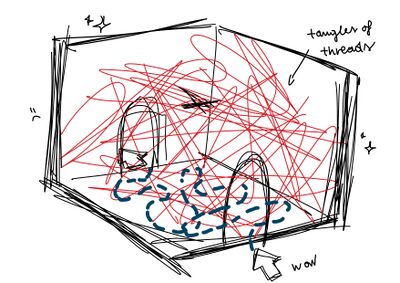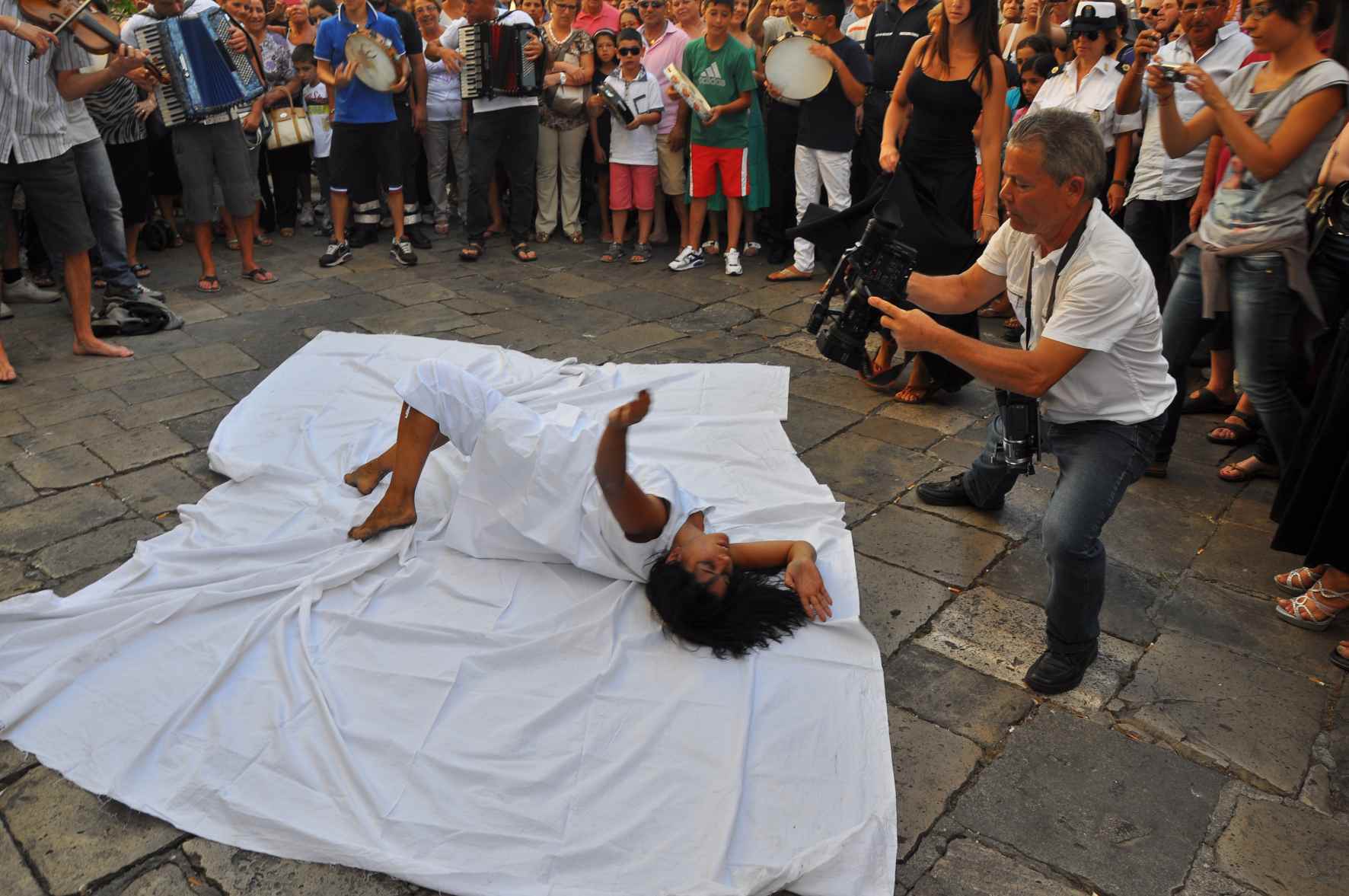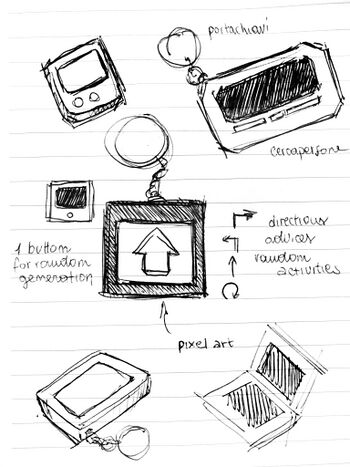User:Alessia/special issue xxiv/Made Be Not May or May That Project
Project That May or May Not Be Made Template *What is it? *Why make it? *Workflow *Timetable *Rapid prototypes *Previous practice *Relation to a wider context *Choices made
xpub tamagotchi
little tamagotchi style device, xpub tamagotchi
https://www.youtube.com/watch?v=0JzORzMnm-E
https://www.youtube.com/watch?v=bPAoemKU1jg
https://github.com/bcskn/Tamabunni/
https://www.youtube.com/watch?v=rGtGivYr1I4
this is the main ispiration:
https://www.youtube.com/watch?v=oVefYmYyLZo
https://www.instructables.com/Arduino-Tamagotchi-Project-I-Am-the-Tamagotchi/
space oracle device
What is it?
A device that let a space communicate with the public.
a device that translates environmental data (light, temperature, signals) from the surroundings into text, simulating communication with the "space" around you. the inputs serve to generate phrases that resemble prophecies or omens.
Maybe even patterns?
Why make it?
Prophecies and omens create a mystical experience, engaging people provoking thoughts about space and the environment. I like the surprise effect, and the random generating aspect, I don't aim to create otherwordly experiences, more play with them.
BUT if it needs to be serious the device could encourage personal reflection through provoking messages and prompts
Workflow
- getting inspired from other similar project
example pagers
- buying material
(Microcontroller Light sensor Temperature sensor Microphone thermal printer acrylic 3d printed case)
- fail few times
- ask Joseph/Louisa for help
- change the workflow to fit my real capabilities
- great final result
Rapid prototypes
PHOTOS HERE
Previous practice
This is an exploration project, so I don't have much experience is creating devices (at all). I would like to get to know more about arduino e circuits, at the same time I am really fascinated about oracles' language and cryptic interactions, that's why I would like to bring this knowledge into prototyping classes as well
Relation to a wider context
Thanks to loitering and Marc Augè I visited plenty of wonderful places around Rotterdam, what could those spaces tell us about themself, or anything really? Maybe they just want to talk, maybe they are angry and don't want anyone around, maybe they are silent
✨HERE LITTLE LIMINAL RESEARCH✨
✨HERE SENKA + ME WIKI PAGE✨
loitering ghost device
What is it?
A device that is able to give you direction for your ultimate loitering experience, a little keycharm device, that will let you find your way, randomly, through the urban jungle.
Why make it?
Sometime you want to loiter, and you get a little bit stressed out, because you want to go somewhere, choose a direction at least, but that is already "getting somewhere" it might not be loitering anymore. That's why a device TO CHOOSE FOR YOU has just arrived. Let the loitering ghost take you around.
Workflow
- getting inspired from other similar projects
- buying material
Display LCD Nokia 5110/3310
Arduino UNO R3 SMD
Arduino M0-mini SAMD21 (I found a M0 clone)
- fail few times
- ask Joseph/Louisa for help
- change the workflow to fit my real capabilities
- great final result
Previous practice
This is an exploration project, so I don't have much experience in creating devices (at all actually).
Relation to a wider context
Thanks to loitering and Marc Augè I visited plenty of wonderful places around Rotterdam, but lot is still there that wait to be found. Using this device I can get away to get into any place because then it will be the device's responsability.
I would like to get to know more about arduino e circuits, at the same time I am really interested in just explore random places and find beauty in hidden corners of urban jungles. Some apps are already doing this, giving out random generated locations to visit, but those usually have some kind of spiritual, mystical, vibe to it, that I enjoy to watch but I don't care about, as I believe loitering should be the main focus.
tarantula bite
https://pad.xpub.nl/p/17-4-24MethodsProjectsThat_alealeale
What is it?
It's a multisensory installation that immerses the visitors in traditional apulian folklore and traditional rituals + a digital archive.
The main theme is the dance that you must do when a tarantula bites you, to get your body healed.
It's a large interactive spider web structure that uses ropes and strings, the visitor is encouraged to move through the web structure and while doing so sensors are triggered, they detect movements and trigger sounds, while the visitor mimics the traditional ritual of dancing to ward off the poison of the tarantula's bite.
Bells and other objects are attached to the structure so that any movements can be noisy. If the idea of a physical web structure is too dangerous then a space open for movements filled with sensors could be the answer.
Then play a bit between physical and virtual.
Why make it?
It is a way to bring people closer to the pre christian traditions and folklore that the culture of southern Italy, especially in rural areas, is still permeated with. Telling about a land rich in superstition, cultural tears, female figures and exorcism as social healing.
In this way, talking only about a specific territory, but also about dance, ritual singing, performance, mental health and links with traditional cultures that are present everywhere.
Workflow
Talk with traditional folk musician and dancers, interview them for the digital archive of the research
Find a space, create archive
Record ambient sounds and folk music to use for the installation
Build the installation
enjoy
Rapid Prototypes

 https://www.forbes.com/sites/yjeanmundelsalle/2021/07/19/web-spinning-artist-chiharu-shiota-creates-moving-and-haunting-installations-out-of-wool/
https://www.forbes.com/sites/yjeanmundelsalle/2021/07/19/web-spinning-artist-chiharu-shiota-creates-moving-and-haunting-installations-out-of-wool/
Previous practice
I researched a lot about traditional folk traditions, apulian landscapes. My bachelor thesis was about fragmented landscapes, magic and rituals. I was part of some workshops and researches about traditional choir singing and pizzica/tarantella dances (the dances born as exorcist dances).
Relation to a wider context
With this installation people are not only going to delve into the intricacies of the apulian territory but also explore a rich tapestry of traditional command practices part of all cultures around the world
https://sabukaru.online/articles/to-share-a-cup-of-tea-with-pierre-sernet
Body Sculpture by Jordan Wolfson
https://www.youtube.com/watch?v=cKeBvoZysgI
Se also Fluxus group (+ Yoko Ono); Valie Export

https://nikidesaintphalle.org/all-the-worlds-a-stage-niki-does-theater/
reader
FROM HERE https://pad.xpub.nl/p/Alessia's-reader
space/place, liminality, psychogeography, sense of belonging, psychology, sociology, rituality, mythogeography, comsumption
✶ Auge, Marc; 1995. Non-places : introduction to an anthropology of supermodernity. London, New York: Verso.
This book explores anonymous and transient spaces typical of the contemporary world, where people pass by without necessarily having an emotional connection to the place itself, without a sense of belonging.
Augé explores the dichotomy between non-places and traditional places, between space and place, showing how the first can influence the sense of belonging and the perception of space in the contemporary era. Augé makes his own predictions, predictions whose halo of obsolescence can already be perceived in a way, yet many of the anthropologist's insights can still be applied to the contemporary world twenty years later.
✶ Smith, Phil. “The Contemporary Dérive: A Partial Review of Issues Concerning the Contemporary Practice of Psychogeography.” , Cultural Geographies, vol. 17, no. 1, 2010, pp. 103–22. http://www.jstor.org/stable/44251315.JSTOR
Phil Smith is a professor, writer and artist, specialised in walking. He is one of the main voices in the psychogeography and mythogeography panorama. With this essay he explains the concept of derivé.
✶ Debord, Guy. "Society of the Spectacle"
Phylosophical marxist critical theory critique of modern capitalist society and the ways in which the dominance of representations images shapes our understanding of the world and ourselves
✶ Bourriaud, Nicolas. "Relational Aesthetics"
It explored the connection of contemporary art practices with their social contexts, exploring the new found obsession in the mid nineties with interactivity and new technologies. To Bourriands all art is relational.
It gives me a different vision on artistic practices, while still I don't agree on everything he likes to intellectualise it's nice to perceive new radical voices about art aesthetic, and it's fun to see people arguing online about it.
✶ B.J. Thomassen. " Liminality and the Modern: Living Through the In-Between"
Through anthropology, sociology and philosophy the author focuses on the concept of liminarity into modernity, the psychological process of transitioning across boundaries and borders, transforming, "becoming"
✶ Arnold van Gennep. "The rite of passage"
Traditional anthropology book that explores the development of the concept of liminarity in the context of small scale societies, transitional stages in an individual's life and all rituals involved
✶ Perec Georges. An Attempt at Exhausting a Place in Paris
The best things to do to reconnect yourself to the place you live is to wander around. Georges Perec took it seriously,exhausting his surrounding
✶ Joukowsky Institute for Archaeology & the Ancient World, Brown University. Archeologies of a place
https://www.brown.edu/Departments/Joukowsky_Institute/courses/archaeologiesofplace/7994.html
Rooting and uprooting introduction, connected to surmodernity and spatial pruduction, ethnographical stance, postcolonialism introduction
essays I am reading:
- Lauzon, Claudette. “The Art of Longing and Belonging.” In The Unmaking of Home in Contemporary Art, 69–103. University of Toronto Press, 2017. http://www.jstor.org/stable/10.3138/j.ctt1whm8v6.7.
- Beghetto, Robert G. “The Sacredness of Digital Liminality.” In Monstrous Liminality: Or, The Uncanny Strangers of Secularized Modernity, 123–44. Ubiquity Press, 2022. http://www.jstor.org/stable/j.ctv2b6z8fb.9.
- Bloom, Peter. “Smart Realities.” In Monitored: Business and Surveillance in a Time of Big Data, 1st ed., 86–111. Pluto Press, 2019. https://doi.org/10.2307/j.ctv9zck7h.8.
- Turner, Victor. Liminal to liminoid in play, flow, and ritual: An essay in comparative symbology. Rice University Studies 1974 https://repository.rice.edu/server/api/core/bitstreams/ede1dfa5-f46d-4f2c-b552-7b501bda2afe/content
- Girard, René. Violence and the Sacred. London: Athlone, 1988.
- Soderback, Fanny. Liminal Spaces: Reflections on the In-Between. Architecture and Culture, vol. 5, no. 3 (2017): 383–93. 2017
- Scott Georgsen, M., & Thomassen, B. (2017). Affectivity and liminality in ritualized protest: Politics of transformation in the Kiev uprising. Theory & Psychology, 27(2), 198–214. doi:10.1177/0959354317700288
- Salvatore, S., & Venuleo, C. (2017). Liminal transitions in a semiotic key: The mutual in-feeding between present and past. Theory & Psychology, 27(2), 215–230. doi:10.1177/0959354317692889
- Boland, T. (2013). Towards an anthropology of critique: The modern experience of liminality and crisis. Anthropological Theory, 13(3), 222–239. doi:10.1177/1463499613496731
- Greco, M., & Stenner, P. (2017). From paradox to pattern shift: Conceptualising liminal hotspots and their affective dynamics. Theory & Psychology, 27(2), 147–166. doi:10.1177/0959354317693120
- Buirski, Nicolette. Liminal emotions and mindfulness traits of well‑regarded supervisors in highly valued doctoral supervisory
relationships SN Soc Sci (2021) 1:46 https://doi.org/10.1007/s43545-020-00049-7


